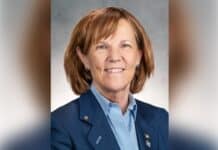
As Gov. Tim Walz unveiled his administration’s $982 million infrastructure spending plan for the upcoming legislative session on Tuesday, he emphasized that the bonding package, about half of which will go towards maintenance of existing state facilities across the state, will be his primary focus at the Capitol in the coming months.
“I am making it very clear; this is my ‘big show’ for this legislative session, and it should be very bipartisan,” Walz said in a press conference at the State Capitol just more than three weeks before the 2024 session begins. “This is what we are going to ask (the legislature) for, these are things coming directly from their communities.”
Also included is a proposal to build a new $22 million State Patrol headquarters at a yet to be determined site in the Twin Cities, a new $48 million Mankato campus for the Bureau of Criminal Apprehension, and $50 million in Housing Infrastructure bonds that will be awarded to developers through competitive request for proposal processes that aim to address homelessness, senior housing and deeply affordable housing needs in various communities.
The governor’s proposal follows a $2.6 billion bonding package the legislature passed on a bipartisan basis in May.
Walz’s promise to stick mostly to bonding priorities during a bonding-specific year comes amid a flurry of pet projects that he and his DFL colleagues in the legislature have indicated they will try to push through their “trifecta” this session as Republicans aim to flip the state House back in their favor in November.
Among those are a bill that would put a ballot amendment before voters this fall to enshrine abortion access and “gender-affirming care” in Minnesota’s constitution, additional firearms restriction measures and a $500 million proposal to heavily subsidize childcare costs for “middle-class” families.
While it’s not yet known when any of those politically polarizing pieces of legislation might be taken up in DFL-controlled committees in the House or Senate, Walz assured media members on Tuesday that the bonding priorities he’s recommended to the legislature are bipartisan in nature and effect. Walz said he’s spoken with Democrats and Republicans on the nearly $1 billion package in recent weeks following a tour of the state to glean from communities “in all corners” their most important infrastructure needs.
Republican votes needed for bonding projects
Bonding legislation requires 60 percent approval in the House and Senate in order to get to the governor’s desk to be signed into law. Walz knows he needs Republican votes.
“This is a very conservative thing, bonding,” Walz said, “Bonding and the keeping up of infrastructure is a very conservative value … I think there will be strong bipartisan support.”
Walz’s bonding proposal comes after the Office of Management and Budget last month projected a $2.4 billion surplus that Republicans warn will dwindle in the coming years after the DFL trifecta moved legislation that spent down the $17.5 billion surplus they used to help fund a $72 billion budget, the largest in state history.
“The ‘insatiable appetite’ for tax increases will only grow this session,” Senate Minority Leader Mark Johnson, R-East Grand Forks, said. “Despite historic funding for education, local schools are proposing local tax increases because Democrats underfunded their mandates. Small businesses are getting hammered with tax hikes, health care costs, and inflation. Consumers are spending more because costs are higher due to inflation.”
While state senators aren’t up for re-election until 2026, all 134 seats in the Minnesota House of Representatives are up for grabs in November, with several swing district seats in play for either party. Democrats currently hold a 70-64 advantage in the House.
Walz’s bonding request at a glance
Here are some of the big-ticket items Walz has included in his infrastructure improvement recommendations, which will likely be examined in detail during the committee process and on the House and Senate floors:
- $128 million for the Department of Corrections, with most of that being dedicated toward asset preservation and repair of facilities across the state. More than $46.5 million would go to fund an expansion of the Rush City Correctional Facility to accommodate for growing needs of its Incarcerated Persons’ educational, rehabilitative, and programming space.
- $103 million for asset preservation across the University of Minnesota’s campuses. Asset preservation would focus on health, safety and accessibility, mechanical systems, utility infrastructure and energy efficiency, and building envelopes.
- Nearly $82 million to HVAC maintenance and safety related improvements across the Minnesota State Colleges and Universities system.
- $100 million for the Department of Natural Resources, with a majority going toward significant “repairs and renovations of DNR capital assets, including buildings, roads, trails, public water accesses, fish hatchery infrastructure, bridges, and recreational facilities.”
- $109 million directed to several Public Facilities Authority projects and programs, including a $39 million match to federal Environmental Protection Agency funds and federal infrastructure bill funding, and to increase lending capacity in the Clean Water and Drinking Water Revolving Funds.
- $74 million to the Department of Public Safety two-thirds of which will fund construction of a new Minnesota Bureau of Criminal Apprehension regional office and laboratory facility in Mankato.
- $50 million in Housing Infrastructure Bonds to be awarded “through competitive request for proposal processes to for-profit developers, non-profit developers, Indian Tribes or tribal housing corporations, and local units of government for supportive housing for people facing homelessness, preservation, senior housing, deeply affordable housing, single family development, and manufactured home communities.”
- $44 million for the Metropolitan Council to help fund engineering improvements along regional busway corridors in the Twin Cities
- $40 million for investments in high-priority trunk highway bridges, including construction capital costs, project development, and engineering activities.
- Nearly $32 million to renovate classroom and common space on the St. Paul College campus.
- $30 million for Department of Human Services related projects, including a $13 million for renovations to the Minnesota Security Hospital and the Minnesota Sex Offender Program (MSOP) facilities in St. Peter.
- $28 million for the Department of Veteran Affairs, most of which would be dedicated to remodel and renovation of one of the buildings at the Minnesota Veterans Home in Minneapolis.
- $10 million for technology to remove manmade contaminants, such as PFAS, from the drinking water supplies of a number of communities in Minnesota that are unable to provide safe drinking water due to these contaminants.
- $10 million for the Amateur Sports Commission, which would go toward asset provision of the National Sports Center in Blaine and improvement of refrigerant systems at a number of local ice rinks.
- $5.6 million for asset preservation for the Minnesota Historical Society properties and a grant program to support preservation of a number of county and municipal historic preservation sites.
- $4 million for infrastructure maintenance at Minnesota Zoo.
Hank Long
Hank Long is a journalism and communications professional whose writing career includes coverage of the Minnesota legislature, city and county governments and the commercial real estate industry. Hank received his undergraduate degree at the University of Minnesota, where he studied journalism, and his law degree at the University of St. Thomas. The Minnesota native lives in the Twin Cities with his wife and four children. His dream is to be around when the Vikings win the Super Bowl.










